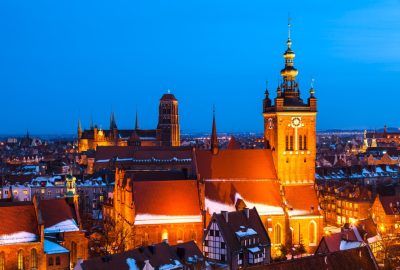The Polish coastline is vast, at least compared to all the other Baltic countries. Such a long coastline, and just one city stands out. Or to be more precise: three cities often portrayed as one. This metropolitan area in northern Poland is called Tricity or Tri-City (in Polish: Trójmiasto) and comprises of Gdańsk, Sopot, and Gdynia. It is a sort of Polish seaside capital. I mean the industrial and trade kind, not the beaches and margaritas kind (that would be Sopot). I’m surprised people call it a hidden gem. I don’t think it’s a hidden gem. On the contrary: it’s an immensely popular destination. Gdańsk’s location at the delta of the Vistula river was the key to its prosperity. It flows through the entire country; from the mountains down south through Krakow and Warsaw right to the Gdańsk Bay delta. Various wares from all over Poland got placed on barges and followed the current to that one port. Gdańsk quickly became the wealthiest city in the country and a maritime mogul. The shipyard was a part of its success. People founded it in 1946 on top of ruins of former German shipyards destroyed during the war. They built over one thousand ships there. Nowadays it’s a shadow of its former glory, but I remember seeing it as a kid. It blew my mind, even seeing it from afar. Not many people realize what it takes to build an actual ship. They organize walking tours and I think it’s worth every penny. Until they start talking about the Solidarity, super boring stuff. Let me give you a “tl;dr”.

Zuraw Crane was built in the Middle Ages as a crane in the port of Gdansk, with its help they placed masts on ships and lifted heavy goods. Now it`s a landmark of Gdansk and Maritime Museum
In 1980 Poland is a communist country and people are unhappy. They form the Solidarity (Solidarność), an independent trade union. Independent is the keyword here and “commies“ never were a fan of independence. They ignored it at first, probably didn’t consider it a threat. Solidarity grew exponentially to the point it couldn’t be swept under the rug. The government had to bend and that was the beginning of the end of the Soviet rule over Poland. Totalitarian order crumbles when people realize that even an iron grip can be broken. Wałęsa was the head figure of Solidarity and was even awarded a Nobel Prize for all his achievements. I never really liked him, but I can’t deny the efforts and charisma it took to pull that off.
Gdańsk is a real treat for people interested in World War II. Take Westerplatte as an example. This is where the war began in Europe. Gdańsk, known as Free City of Danzig back then, was inhabited mostly by a German population. Westerplatte was just a tiny Polish outpost. Shots were fired from all directions. Shots from the city, shots from the bay, shots from outer space! It was pure chaos. Worst part is that they couldn’t count on any supplies or reinforcements. They held the Germans back for seven days. You can’t help but compare Westerplatte to Thermopiles. It really was some heroic stuff. All the ruined fortifications are still there. You can see for yourself what they were dealing with. Continue the learning experience at the Museum of the Second World War. I think it’s one of the best museums in Poland right now. The part I like the most is that it’s not build around this victim complex, which unfortunately is pretty common and exploited in Poland nowadays.

St. Catherine's Church in Gdansk: the oldest and most interesting parish church of the old city; in the background stands the massive tower of the Basilica of St. Mary
No visit to Gdańsk is complete without seeing the Old Town. In fact, it was this city’s main point of interest for decades. All the important stuff is laid out along the Royal Route. This is the route the Polish kings took to show off their pimped-out carriages and the freshest robes. You can join one of the tours led by guides. I promise they will tell you stories about every single cobblestone paving the Old Town. I prefer to look at it as a whole, not dissecting every little detail. There are, however, a few spots worth getting deeper into. The Artus Court is one such place. It used to be a hangout for wealthy merchants during the Middle Ages. They chilled, had drinks and talked about everything excluding business. Strippers? Possible. Now it serves a similar role hosting important meetings. It’s located at the Long Market, sort of the main square of Gdańsk’s Old Town. The Long Market is the central tourist hub of Gdańsk. You won’t see many locals as everything is hugely overpriced and aimed towards foreigners. It’s not unaffordable, but it does put a dent in your wallet. Smoked eel is something you need to try no matter the price. Smoked eel is better than sex.




No one commented yet. Be the first.